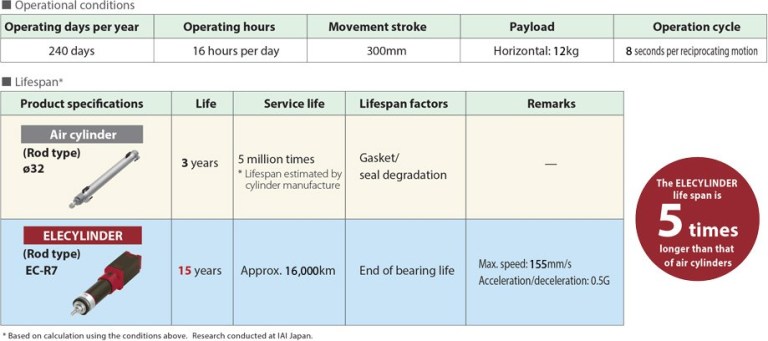Pneumatic actuators have historically dominated the industrial market when simple motion control is needed. They are inexpensive and generally perform well. In the last few years, however, almost every pneumatics company has released and is promoting electric actuators as a viable alternative to air.
Some companies, like Intelligent Actuator have taken another route and don’t offer a pneumatic product at all. They are betting entirely on electric actuators to eat into the sizeable air cylinder market… and for good reason. Many manufacturing companies are implementing sustainability initiatives, and one of biggest culprits of energy consumption is compressed air. Research has concluded that typical plant air compressors are only 14% effective at the air cylinder. In other words, for every $1 it costs to run the compressor, $0.86 of that dollar is lost due to inefficiency — and that assumes you are in a “no air leak” environment. A small 3/8″ air leak could result in a $30,000 cost.

This presents an incredible opportunity for manufacturing companies to dramatically lower energy bills by implementing electric actuators. Does that mean that electric actuators are right for your company?
Let’s take a look at the pros and cons of air vs. electric actuators…
PNEUMATIC VS. ELECTRIC
Pneumatic Actuators
Pros:
- Lower up-front cost
- Easy to setup
- Readily available
- Wide variety and selection from many suppliers
Cons:
- High energy cost from compressed air
- Usually limited to 2 or 3 positions
- Performance changes over time due to environmental conditions
- Components require maintenance or replacement
Electric Actuators
Pros:
- Control over accel/decel and velocity via servo motor
- Infinite number of positions
- Complete control of motion profile
- Can be easily repurposed for a different application
- Zero maintenance
Cons:
- Generally higher up-front cost
- Hassle of replacing existing air cylinder
- Not all maintenance personnel have skillset to configure
UP-FRONT COST AND PROGRAMMING
The two main items — in our opinion — that is holding back electric actuators from taking over air today are up-front cost and perceived complicated programming. Let’s quickly dive into each.
First, the cost is quickly coming down on electric actuators. Soon, we will likely see them become equal in cost. In the meantime, the energy savings realized by using electric actuators will quickly even out the costs.
Secondly, manufacturers like IAI have realized that the perception of having to program the actuator was slowing adoption. To combat that, they are now offering solutions like the EC ELECYLINDER that requires no programming at all and operates with ON/OFF configuration similar to a solenoid valve. While electric actuators have the ability to do complex tasks, deployment of ones with simple motion profiles can generally be done by maintenance personnel.
A SOLUTION FOR FUTURE NEEDS
Lastly, we are seeing that customers want each piece of automation do a little bit more than the generation behind it. We often hear things like: “While it just needs to move the part from point A to point B, it would be really great if we could… (fill in the blank)”. Electric actuators give you flexibility. Air cylinders do not.
While electric actuators are relative newcomers compared to the 50-year-old pneumatic technology, they are poised to take over significant market share. Much like digital cameras replaced film and MP3s replaced cassette tapes, it is likely only a matter of time before the air cylinder becomes obsolete.
If you have a sustainability initiative or would like to investigate whether or not electric actuators are right for your facility please contact us. To request a quote, contact Inside Sales at The Proud Company at 412.838.0230.

Recent Comments